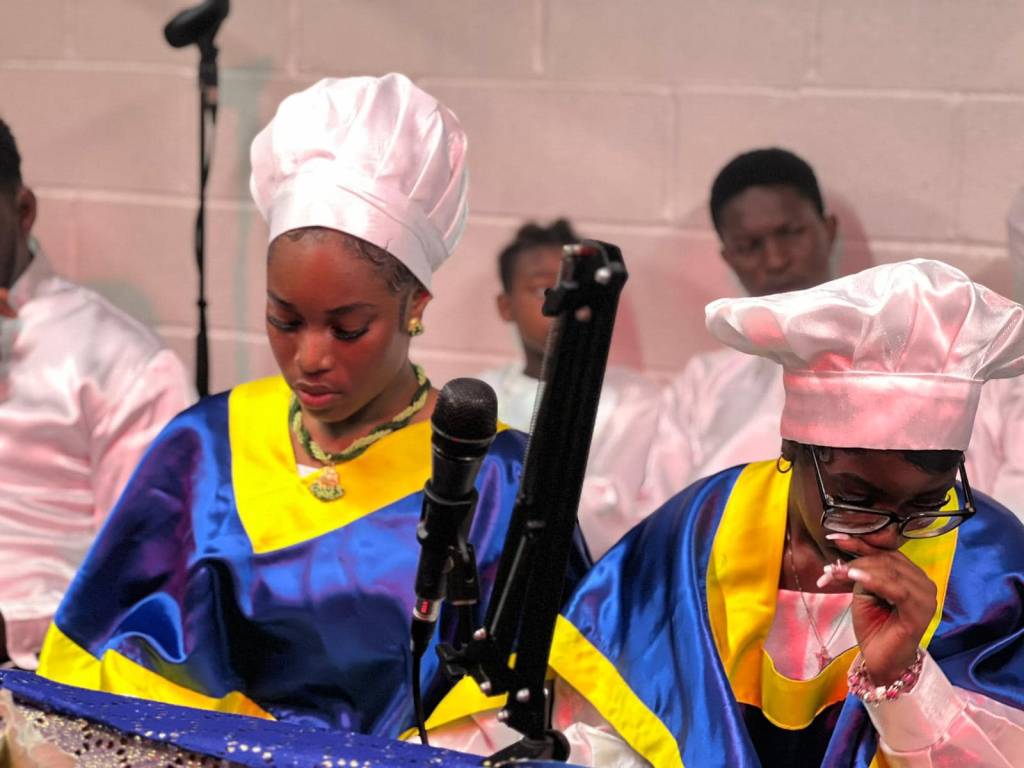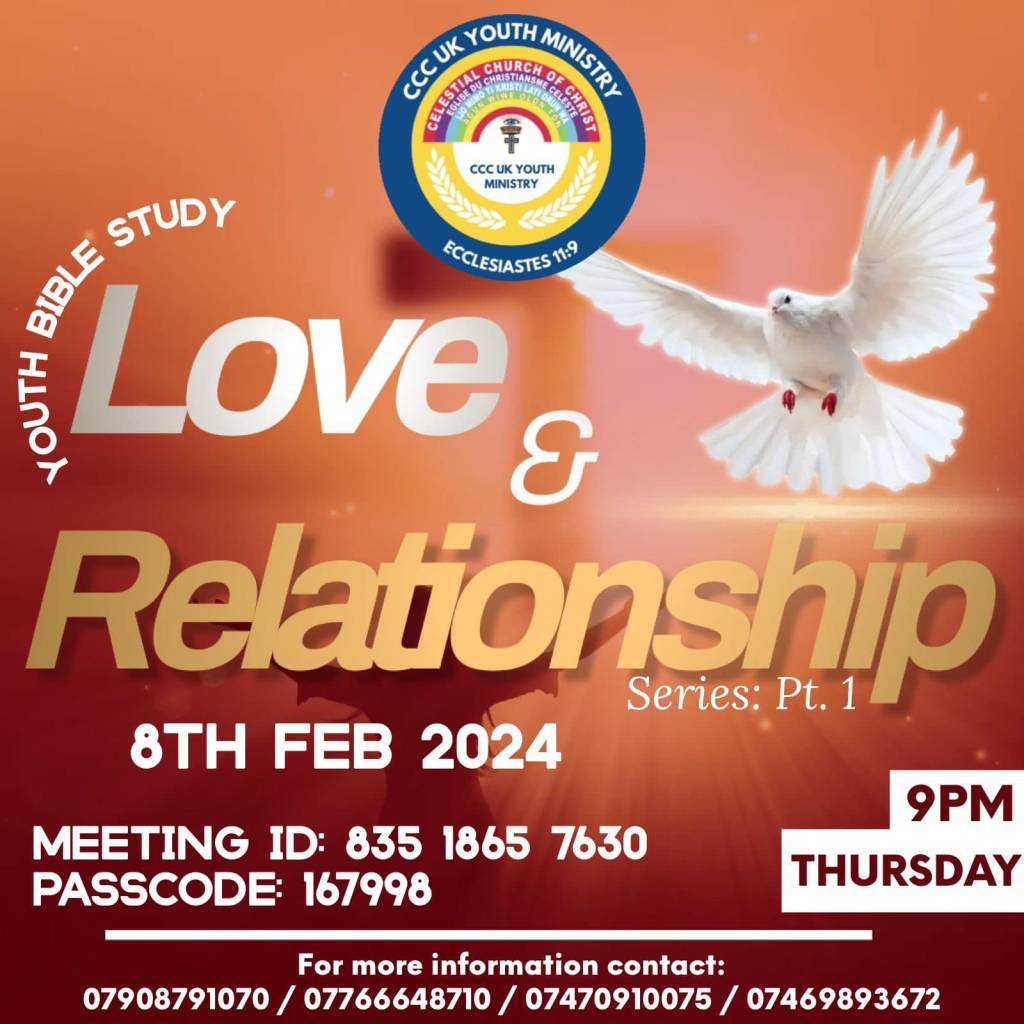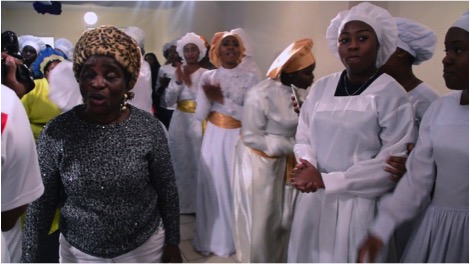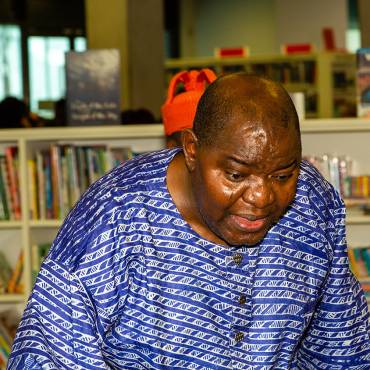‘Yoruba’ Delights and Dilemmas: A Few Things Young British Nigerians Face within “Aladura” Church Settings
Even amongst the typical rainy and windy terrains of most weekend mornings within South London and beyond; one will find a growing number of young Nigerian British followers modestly dressed in white robes growing in robust expertise of Yoruba hymnals and religious practices. Praise and worship, dancing with spiritual fervor paying within drawn-out services on Sunday mornings and Friday nights during most weeks compliment lengthy sermons and revival prayer.

Source: Horeb of God Parish, Canning Town E16
In a time of increased never-ending diaspora debates surrounding identity crisis, heritage discontinuation and dilemmas of belonging, ‘white garment’ churches also known as “aladura” which means “praying people” in Yoruba, represent a denomination of Christianity characterised by its adherents taking off shoes before entering, avoiding wearing black or red for services and uniformed in joyful attitudes towards praise, prayer and attire. Classical Aladura churches include, the Cherubim and Seraphim Church (C&S); The Church of the Lord (Prayer Fellowship) Worldwide (TCLPFW); the Christ Apostolic Church (CAC); and the Celestial Church of Christ (CCC). The most popular among the African Initiated Churches (AIC) today, is the Aladura Church movement. The Aladura churches are independent African churches (or African Instituted Churches—AICs) that emphasize prayer and healing. Both C&S and CCC that are highlighted within this article are white garment churches but different denominations. C&S was founded by Moses Orimolade while CCC was founded by Samuel Oshoffa.
Unknown to some; the church has often been described as a humble yet vibrant spiritual space for many teenagers and young adults, indicating a positive environment for those seeking spiritual connection. And here are 5 reasons how the church is fostering and community building our Nigerian-British teenagers.
A love for hynms and spiritual songs
High-life, Afrobeats and Amapiano are often perceived to be on top of many of our teenage and young adults spotify playlists and personal favorites. However, one cannot underestimate the role that spiritual music played within these aladura church settings have on their young minds. Musicians playing drums, usually accompanied by a keyboardist and a guitarist gather momentum simultaneously as the pace of the hymns increase. Clapping, raised hands, eyes closed and repetitive melodies are paralleled with lengthy prayers, extended bible readings and prostrating men and women in prayer. The children turned teenagers grow into young adults connect the dots of how indigenous Yoruba notions of spiritual power are fused with Bible interpretations. These help shape the life-worlds of our British-Nigerian students turned adults, and underpin the rituals of prayer and revelation that answer to their practical and existential needs.
Relationship Fostering
 Source: CCC UK Youth Ministry
Source: CCC UK Youth Ministry
It’s not just memories of church that we carry over from adolescence into adulthood; but lasting friendships and relationships. Meaningful relationships with fellow humankind can only begin with a meaningful relationship with God above according to the teachings of the church.
“A lot of the young people who come (to white garment churches) were born in it. When you were born here, or even your parents were born here, the services are harder to understand.” says a 25-year-old woman at the annual harvest, an all-day festival hosted once a year at the Celestial Church of Christ in Peckham (who wants to remain unnamed). Nevertheless many C&S and CCC church settings represent a platform where friendships, groups, discussions, relationships and marriages begin, blossom and continue.
And whilst many are lamenting of the difficulties amongst the distractions of technology and social media on what is now seen as ‘old fashioned’ communication and interacting skills (as seen with the aforementioned quote above); various seminars, counselling sessions, marriage studies alongside illuminating testimonies, reminiscences, and comments by the worshippers in services are are aiding and ministering to our youth in this area.
Humility and Uniformity

Source: CCC Hephzibah Parish UK, Edmonton
Everyone is equal; there is an intentional desire for uniformity and modesty by all being dressed in white. Because the white garments symbolises that the baptized person is now clothed in the mantle of God and will start a clean life in His eyes and in the eyes of the church; part of living upright is a regard fellow brothers and sisters as each being “fearfully and wonderfully made” (Psalm 139). Annual youth praise events, quizzes and the late September annual harvest festival all represent occasions for youth to joyfully gather symbolising tradition, spiritual cleanliness and uniformity.
Extending Yoruba Culture and Language
It’s not just about singing, dancing and worshipping while dressed entirely in white – which outsiders often remark about the church; nor is it the often cited differences of “na so so blue and red candles, strong perfumes, chants, invocation and incantations” that have led critics to question whether they are a different denomination or even separate from Christianity – but the Yoruba cultural and linguistic underpinnings of many of their practices. For example, congregants attend wearing white garments referred to as ‘Aso Adura’ (clothes of prayer). The Cherubim and Seraphim denomination was founded in Nigeria in 1925 by Moses Orimolade Tunolase Yoruba culture and tradition are incorporated into the service and worship, as well as being the root of the white garment worn by all members for worship.
Many journalists, ambassadors and photographers have sought to address some of these prejudices critics label against the church with regards to these Yoruba influences on historical and biblical Christian service. Photographers such as Tobi Sobowale’s photography series “The C&S church in the United Kingdom” focuses on the intimate church services – looking at smaller C&S communities with the aim of humanizing and addressing “the stigma of the ‘white garment church’, and tackle issues of race and religion in the UK”, documenting an overlooked Christian community.
Addressing prejudices and stereotypes
“Your view lenses begin to work and you remember all that have been said about them- the idol worshipers who use candles and do fetish things on the beach. You do not think there could be true Christians in their folds. You have heard stories and have even seen some with your eyes. False vision fabricators, satanic clerics, bleached skinned choristers, polygynist leaders, and the list goes on.”
Hannah Ojo, White Garment and Inglorious Identities (2013)
 Source: Unity Revival (2018) by Yetunde Inherited
Source: Unity Revival (2018) by Yetunde Inherited
It is worth mentioning that many within these Aladura churches are aware of their criticisms from other Christians and outsiders alike. British Nigerian Photographer and Visual storyteller Tobi Sobowale within her documentary project ‘The C&S Church in the United Kingdom’ desires to humanize and address the stigma of the ‘white garment church’, and tackle issues of race and religion in the UK, documenting an overlooked Christian community. Indeed, evidence of marginalization is seen to come from outsiders and former members alike. Former C&S and CCC congregants have left the church accompanied by unashamed public statements of finding ‘true faith’ in ‘Christ alone’ such as Queen Adetutu, Abednego Lufile and Latonia Oyeniran highlight this matter undoubtedly. Accusations include how many rituals are rooted in the Yoruba religion (wearing white, being near water, praying with fruit offerings, etc.) with ‘idolatrous’ pictures of a white Jesus or virgin Mary next to each other on candle lit alters in the UK are underpinned by common stereotypes in Nigeria that church is under the operation of a marine spirit masquerading as Jesus following some biblical principles but still not seen as bible believing churches.
Many within the C&S movement in particular have often responded however that to say all aladura churches engage in pagan worship is evidence of hasty generalization. Perhaps once upon a time it was obtainable in the past according to Hannah Ojo because some of the converts were idol worshipers who joined the fold because they could identify with the use of their native language (which sinks more into their inner deity) other than the practice in the orthodox churches where the language of worship was that of the colonial masters. Thus, these practices which are validated by the Old Testament have now been eroded with civilization, coupled with better scriptural understanding and agreed theological acceptance that Christ’s death and resurrection has “once for all” finished God’s perfect redemption work for Christians to be content in faith alone through grace alone in Christ alone (Heb 13:11-13, 1 Pet 3:18).

Source: Agbara Baba Ka, Minstrel Mercy E. Fulani x Yetunde Inherited
In Essence, it is worth pointing out that the aforementioned examples cited merely represents a snippet and not a total discourse of the blessings and burdens young congregants within Britain’s white garment church setting face on a weekly basis within London and beyond. The Cherubim and Seraphim Youth Revival, Yetunde Inherited and Filee’s Records are visually epitomizing the vibrancy and spirituality of the ‘aladura’ church scene within Britain to tremendous effect and more grease to their elbows. So the next time you come across some of these folks in white garments; be rest assured that there is a faith, a history and a journey this community is coming from and heading to.
Written T. Alli


